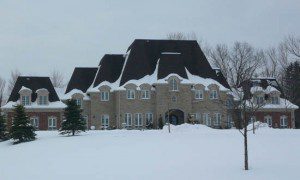
In most parts of Canada, they’re located in the suburbs where the lots are larger. In downtown areas they’re called mansions. In some older communities they’re found on former estates. In fact, out in the country, they’re described as estate homes. A few weeks ago, we were driving past a group of them north of Stouffville and an older passenger in our car gasped.
“Unbelievable aren’t they,” I said.
She nodded and reacted with an unexpected comment: “How on earth would anybody clean something like that?” she said.
I hadn’t thought about those million-dollar, estate homes quite that way before. But my older friend’s comment brought my concern about such places into perspective. If one happened to live in a house such as that – with three or four stories, probably 25 or 30 rooms (no doubt including a bathroom for each member of the family that lived there) and a million nooks and crannies for dirt to gather – cleaning it would be a nightmare.
The cleaning dilemma aside, I thought the greater question was: why would anyone need a house that large? When most educated societies acknowledge the planet’s limited resources, why would anyone design, build or sell such a monstrosity? And I guess the easy answer is: because there are enough of us who want them designed, built and available for purchase.
I remember when we first moved into our most recent house 25 years ago. Admittedly, first we looked into purchasing an acreage, because the women in the family had a passion for horseback riding and that required space. Well, it turned out that the space the hobby required was far too expensive for the incomes available to make it possible.
So, we settled for a bungalow in town and commuted to the rented barn, stall and arena space so the ladies could still get their horse fix. The house we chose to live in was tiny by most people’s standards. Today, with the girls grown and gone, the house that remains is more than enough for two empty-nesters.
Oddly, that’s an evolution I don’t think a lot of developers and demographers have fully grasped. Families expand and contract fairly predictably. And yet we insist on building ever larger houses, so that on the day the remaining inhabitants number one or two, the space in which they’re living has become far greater than they will ever need. Eventually, when the impact of the 1945-1960 baby boom has disappeared, far too many communities (maybe even our own) will be comprised of over-sized homes with just a couple or three people rattling around inside them. That’s either short-sighted or selfish. Or both.
Not a day in our lives goes by when we don’t hear about some corner of the world – even in Canada – where space is at a premium. We see it in images of congestion in downtown Beijing, Mumbai or even Vancouver. We see it in the space gobbled up by urban sprawl and the network of highways designed to move populations between downtown and the suburbs in such places as Los Angeles, London and Montreal. Or we witness the world’s waterfronts cluttered with hundreds of high rises all competing for the view in Hong Kong, Miami and Toronto. But far too much of that space, I think, is occupied by housing that consumes more space than it needs.
And if it’s not housing that gobbles up the space, it’s shopping malls. In Toronto, look at the way the former shopping plazas at Don Mills and Lawrence seemed to expand and take over neighbouring residential land when they became the Shops at Don Mills. And just this week, developers announced the expansion of Yorkdale, one of the city’s most congested malls (just ask anybody who’s tried to shop or park there during Christmas or Boxing Day). The developer plans to add 40 more stores and increase its parking capacity by 800 stalls. Just how it plans to accomplish that within the existing space, the developer didn’t say. But Yorkdale will spend $220 million in the attempt.
Some would argue that the increased density of housing and commercial development in such cities as Toronto is actually a better use of the space available. Planners and demographers call the process “densification,” or making maximum use of a minimum amount of land. But I think the process still incorporates over-sized houses. I visited one of those downtown high rises not so long ago. A two-bedroom condo contained an entrance room, a sitting room, a huge dining room, separate living room, den and several bathrooms (as well as the en suite). It seemed the apartment occupied a quarter or third of the entire floor. It felt like the downtown equivalent of that estate home near Stouffville.
I didn’t ask how the owner kept a place that big, clean.